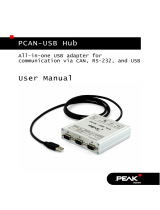Page is loading ...

PCAN-Router Pro
4-Channel CAN Router with Data Logger
User Manual
Document version 2.5.0 (2019-03-13)

PCAN-Router Pro – User Manual
2
Relevant products
Product Name Part number Model
PCAN-Router Pro IPEH-002212 Firmware version 1.4.x
PCAN is a registered trademark of PEAK-System Technik GmbH.
All other product names in this document may be the trademarks or registered trade-
marks of their respective companies. They are not explicitly marked by ™ or ®.
© 2019 PEAK-System Technik GmbH
Duplication (copying, printing, or other forms) and the electronic distribution of this
document is only allowed with explicit permission of PEAK-System Technik GmbH.
PEAK-System Technik GmbH reserves the right to change technical data without
prior announcement. The general business conditions and the regulations of the
license agreement apply. All rights are reserved.
PEAK-System Technik GmbH
Otto-Roehm-Strasse 69
64293 Darmstadt
Germany
Phone: +49 (0)6151 8173-20
Fax: +49 (0)6151 8173-29
www.peak-system.com
info@peak-system.com
Doc
ument version 2.5.0 (2019-03-13)

PCAN-Router Pro – User Manual
3
Contents
1 Introduction 5
1.1 Properties at a Glance 6
1.2 Operation Requirements 7
1.3 Scope of Supply 8
2 Connectors 9
2.1 Power (Voltage Supply) 9
2.2 CAN 1 to CAN 4, D-Sub 9-pin 10
2.3 CompactFlash Card 11
3 Hardware Adjustments 12
3.1 Using an Alternative CAN Transceiver Module 13
3.2 Adjusting the Termination for a CAN Bus 15
3.3 Setting the Router ID for the Configuration 16
3.4 Enabling the 5-Volt Supply for External
Devices 17
3.5 Enabling the Supply of the Router via a D-Sub
Connector 18
3.6 Replacing the Button Cell for the Real-time
Clock (RTC) 20
4 Installing Software 21
5 Operation 23
5.1 Turning On the PCAN-Router Pro 23
5.2 Default Bit Rates of the CAN Channels 23
5.3 Shipping Configuration 24
5.3.1 Structure of the Status Messages 25
5.4 Setting the Real-Time Clock 27
5.5 Status LEDs 30

PCAN-Router Pro – User Manual
4
5.6 Power-down Mode 31
5.7 Wake-up 31
5.7.1 Wake-Up with Supply Voltage 31
5.7.2 Wake-up via CAN 32
5.7.3 Wake-Up Externally by High Level 32
5.7.4 Wake-Up by Real-Time Clock (RTC) 33
6 Logging CAN Traffic onto a CompactFlash Card 34
6.1 Preparing a CompactFlash Card 34
6.2 Preparing a Configuration for Recording 35
6.3 Using the Recorded CAN Traffic 37
7 Creating Custom Firmware 39
7.1 Installing the GNU ARM Toolchain 39
7.2 Library 40
7.3 Firmware Examples 40
7.3.1 Compiling a Firmware Example 41
8 Firmware Upload 42
8.1 System Requirements 42
8.2 Preparing Hardware and Software 43
8.3 Sending the Firmware 45
9 Technical Specifications 49
Appendix A CE Certificate 52
Appendix B Dimension Drawing 53
Appendix C Contents of a CompactFlash Card 54
Appendix D Disposal Information (Battery) 55
Appendix E Router Resources 56

PCAN-Router Pro – User Manual
5
1 Introduction
The PCAN-Router Pro links the data traffic from up to four High-
speed CAN buses. The behavior of the router is configured via the
CAN bus with the provided Windows program PPCAN-Editor. As
well as pure forwarding, the CAN data can be processed, manipu-
lated, and for example, filtered in a number of different ways. There
are a variety of function blocks and other settings available to the
user for configuration setup. Furthermore, there is a virtual fifth
CAN channel which is used for recording all data traffic to a
CompactFlash card.
As an alternative to the standard firmware which the PCAN-Router
Pro is equipped with at delivery, custom firmware based on the
ARM microcontroller NXP LPC2294 can be created and implemen-
ted. The scope of supply includes a library and the Yagarto GNU
ARM toolchain (contains the GNU Compiler Collection GCC for C
and C++).
CAN transceiver modules in the PCAN-Router Pro allow a flexible
adaptation of each CAN channel to the requirements. For example,
Low-speed and Single-wire CAN transceivers are also available on
request.
The documentation for the PCAN-Router Pro has multiple parts:
PCAN-Router Pro - User Manual (this document):
Explains hardware adjustments, the operation of the device, and
the hardware-specific settings in the PPCAN-Editor (Appendix E
on page 56).
PPCAN-Editor - Documentation (program help):
The help of the configuration program PPCAN-Editor for
Windows, accessible via the Help menu or via F1.

PCAN-Router Pro – User Manual
6
PPCAN-Editor - References (PDF file):
Explains the function blocks and the mathematical functions that
are implemented in PPCAN-enabled devices (like the PCAN-
Router Pro).
1.1 Properties at a Glance
4 High-speed CAN channels via pluggable transceiver modules
(Wake-up capability); alternatively, Low-speed, Single-wire, and
opto-decoupled High-speed modules, as well as High-speed
modules without wake-up function available
Wake-up via a separate input or the CAN bus
Complies with CAN specifications 2.0 A/B
CAN connection D-Sub, 9-pin
CAN termination switchable, separately for each CAN channel
Slot for CompactFlash card
Battery-buffered real-time clock (RTC), can also be used for
wake-up
Beeper
Status LEDs for CAN channels, CompactFlash card,
microcontroller, and power supply
NXP LPC2294 microcontroller
Aluminum casing with flange; DIN rail fixing option available on
request
Voltage supply from 8 to 27 V, protection against overvoltage
and reverse polarity
Extended operating temperature range from -40 to +85 °C (-40 to
+185 °F)

PCAN-Router Pro – User Manual
7
Properties of the standard firmware:
Comprehensive configuration with the Windows software
PPCAN-Editor 2
Various function blocks for data processing and manipulation
Configurable beeper
Configurable status LEDs for CAN channels
Recording of CAN data and error frames to a CompactFlash card
Conversion of logging data to various output formats using
Windows program
1.2 Operation Requirements
Voltage supply 8 – 27 V DC (e.g. car battery)
For configuring via CAN (standard firmware):
Computer with CAN interface of the PCAN series
(e.g. PCAN-USB)
CAN cabling with correct termination
Windows 10, 8.1, or 7 (32/64-bit) for the configuration
program
For converting logged CAN data:
Computer with card reader for CompactFlash cards
Windows 10, 8.1, or 7 (32/64-bit) for the conversion
program
Sufficient space for data on the hard disk (up to 5 times of
the initial file size from the CompactFlash card, e.g.
1 GByte + 4 GByte)

PCAN-Router Pro – User Manual
8
1.3 Scope of Supply
PCAN-Router Pro in an aluminum casing
Mating connector for power supply
Configuration software PPCAN-Editor 2 for Windows
Conversion software PEAK-Converter for Windows
Industrial CompactFlash card (min. 1 GByte)
Windows development software
(Yagarto GNU ARM toolchain, flash program)
Library with programming examples
Manual in PDF format

PCAN-Router Pro – User Manual
9
2 Connectors
2.1 Power (Voltage Supply)
The operation of the PCAN-Router Pro requires a voltage source
with a nominal 12 V direct current voltage, 8 to 27 V are possible.
The input is electronically protected against reverse polarity and
overvoltage.
The connection is done with the supplied mating connector
(Phoenix Contact MC1,5/2-STF-3,81) for fastening cable strands. The
polarity is as follows:
Note: After applying the supply voltage, the PCAN-Router Pro
needs a wake-up signal in order to start operation. Having
customized equipment, if there is no CAN transceiver module
with wake-up function, the PCAN-Router Pro must be switched
on with an external wake-up signal (see section 5.7.3 on page
32).

PCAN-Router Pro – User Manual
10
2.2 CAN 1 to CAN 4, D-Sub 9-pin
A CAN bus is connected to a 9-pin D-Sub port.
Pin assignment of the ports CAN 1 and CAN 2
Pin assignment of the ports CAN 3 and CAN 4
The assignment of the CAN pins relies upon the used CAN
transceiver module:
Module name Transmission
standard
Special function Used CAN lines
CAN-HS High-speed CAN
ISO 11898-2
CAN_L, CAN_H
HSGE2 High-speed CAN
ISO 11898-2
Galvanic isolation up to
300 V for the CAN interface
CAN_L, CAN_H
CAN-HS-1041
(standard)
High-speed CAN
ISO 11898-2
Wake-up via CAN CAN_L, CAN_H
CAN-LS Low-speed CAN
ISO 11898-3
Wake-up via CAN CAN_L, CAN_H
CAN-LS-SW Single-wire CAN
SAE J2411
Wake-up via CAN CAN_SW

PCAN-Router Pro – User Manual
11
The D-Sub connectors have pins with additional functions:
Connectors Pin Function See section…
CAN 1, CAN 2,
CAN 3, CAN 4
1 5-Volt supply for external devices (to be
activated on the circuit board)
3.4 on page 17
CAN 3, CAN 4 4 Input for external wake-up signal 5.7.3 on page 32
CAN 3, CAN 4 9 Supply of the router via a D-Sub
connector (to be activated on the circuit
board)
3.5 on page 18
Note: The additional functions at the D-Sub connectors are not
galvanically isolated. When using the transceiver module
HSGE2, galvanic isolation is only provided for those pins that
are assigned to CAN communication at the corresponding D-
Sub connector (2: CAN_L, 7: CAN_H, 3: CAN_GND).
2.3 CompactFlash Card
To log the CAN data traffic (trace) you can use CompactFlash cards
(CF cards) with a maximum capacity of 2 GByte.
The CF slot is located on the rear of the PCAN-Router Pro. The CF
card is properly inserted if it flushes with the rear panel.
Note: When you want to insert or eject a CompactFlash card,
the PCAN-Router Pro must be turned off (no power supply or
power-down mode, Power LED off). Else the card is not
detected or data gets lost.
About the use of a CF card see chapter 6
Logging CAN Traffic onto a
CompactFlash Card
on page 34.

PCAN-Router Pro – User Manual
12
3 Hardware Adjustments
You can adjust some hardware settings on the circuit board of the
PCAN-Router Pro (corresponding section in brackets):
Using an alternative CAN transceiver module (3.1 on page 13)
Adjusting the termination for a CAN bus (3.2 on page 15)
Setting the Router ID for the configuration (3.3 on page 16)
Enabling the 5-Volt supply for external devices (3.4 on page 17)
Enabling the supply of the router via a D-Sub connector (3.5 on
page 18)
Replacing the button cell for the real-time clock (RTC) (3.6 on
page 20)
Do the following to remove the circuit board from the casing of
the PCAN-Router Pro in order to access the possibilities for
adjustments on the board:
Attention! Electrostatic discharge (ESD) can damage or destroy
components on the circuit board of the PCAN-Router Pro. Take
precautions to avoid ESD when handling the circuit board.
1. Along the top edge of the casing remove two screws on
each the front and the rear of the PCAN-Router Pro.
2. Take off the upper casing part.
3. On the front of the PCAN-Router Pro, remove the lower two
screws.
4. Together with the front panel, pull out the circuit board into
front direction from the casing's lower part.
The subsequent assembly is done in reverse order. Take care about
the light guides on the casing top.

PCAN-Router Pro – User Manual
13
3.1 Using an Alternative CAN Transceiver
Module
For each of the four CAN connections an alternative CAN
transceiver module can be inserted.
Following modules are available:
Module name Transmission
standard
Special
function
Used CAN
lines
Default bit rate
CAN-HS High-speed CAN
ISO 11898-2
CAN_L, CAN_H
500 kbit/s
HSGE2 High-speed CAN
ISO 11898-2
Galvanic
isolation up to
300 V for the
CAN interface
CAN_L, CAN_H
500 kbit/s
CAN-HS-1041
(standard)
High-speed CAN
ISO 11898-2
Wake-up CAN_L, CAN_H
500 kbit/s
CAN-LS Low-speed CAN
ISO 11898-3
Wake-up CAN_L, CAN_H
125 kbit/s
CAN-LS-SW Single-wire CAN
SAE J2411
Wake-up CAN_SW 33.3 kbit/s
Positions of the transceiver modules for the four CAN channels (CAN 1 on the left)

PCAN-Router Pro – User Manual
14
Do the following to replace a transceiver module:
1. Remove the retaining screw from the transceiver module to
be replaced. Take care of the spacer and the nut that are
possibly get loose.
2. Pull off the transceiver module upwards from the main
board.
3. Plug the alternative transceiver module onto the socket.
Make sure that the hole in the transceiver module is aligned
to the corresponding hole in the main board.
4. Secure the transceiver module with the screw, the spacer,
and the nut.
At restart, the PCAN-Router Pro automatically detects the type of
the inserted CAN transceiver module and adjusts the according
default bit rate for the CAN channel (see table above). The bit rate
can be changed by a configuration.
Note: Having customized equipment, if there is no CAN
transceiver module with wake-up function, the PCAN-Router
Pro must be switched on with an external wake-up signal (see
section 5.7.3 on page 32).

PCAN-Router Pro – User Manual
15
3.2 Adjusting the Termination for a CAN
Bus
Depending on the used CAN transceiver module you can activate or
change the CAN bus termination for each CAN connection CAN 1 to
CAN 4 with switch blocks S1 to S4. Switches 1 and 2 on a switch
block always must have the same position. By default, the switches
are set to off (opposite to position “ON” on a switch block).
Positions of the switch blocks for CAN termination;
ON switch position is labeled on the switch blocks
Termination at switch position* Type of transceiver
Off ON
High-speed CAN (ISO 11898-2) none
120 between
CAN_L and CAN_H
Low-speed CAN (ISO 11898-3)
4.7 k for
CAN_L and CAN_H
1.1 k for
CAN_L and CAN_H
Single-wire CAN (SAE J2411)
9.1 k for CAN_SW 2.1 k for CAN_SW
* Both switches of a switch block

PCAN-Router Pro – User Manual
16
3.3 Setting the Router ID for the
Configuration
The board of the PCAN-Router Pro has a rotary switch with 16
settings to determine the Router ID (0 - F hex = 0 - 15).
Position of the rotary switch for the Router ID
When the PCAN-Router Pro is started with the standard firmware,
that configuration is loaded from the internal memory whose num-
ber matches the specified Router ID. In addition, the Router ID gives
the PCAN-Router Pro a unique identification during the PPCAN com-
munication (configuration transfer). For the transmission of CAN
messages during normal operation this Router ID is not relevant.
Note: The rotary switch setting “F” is reserved for an upload of
new firmware (start of the bootloader) on the PCAN-Router Pro
with a serial number of 100 and above.
This is how you change the Router ID of a PCAN-Router Pro:
1. Change the position of the rotary switch with a small slot
screwdriver.

PCAN-Router Pro – User Manual
17
2. Restart the PCAN-Router Pro by briefly cutting off the power
supply.
After the restart the changed Router ID will be active. Before
the restart changes made at the rotary switch will have no
influence on operation.
During operation with a configuration the LED “μC Status” blinks
green every second. If a configuration for the set Router ID does not
exist, the LED blinks twice as fast.
3.4 Enabling the 5-Volt Supply for
External Devices
A 5-Volt supply can optionally be routed to pin 1 of a D-Sub
connector (independently for each connector) by setting solder
jumpers on the circuit board of the PCAN-Router Pro. Thus devices
with low power consumption (e.g. bus converters) can be directly
supplied via the D-Sub connector. The current output is limited to
100 mA for each connector.
Proceed as follows to activate the 5-Volt supply:
Set the solder jumper(s) on the circuit board of the PCAN-Router
Pro according to the desired function. During this procedure take
especially care not to produce unwanted short circuits on the board.
The following figure shows the positions of the solder fields on the
circuit board. The table below contains the possible settings.

PCAN-Router Pro – User Manual
18
Position of the solder fields on the bottom side of the circuit board
for the 5-Volt supply at the D-Sub connector
(JP12 on the right, JP15 on the left)
Connection Solder field
No
function
+5 V
100 mA
CAN 1, Pin 1 JP12
CAN 2, Pin 1 JP13
CAN 3, Pin 1 JP14
CAN 4, Pin 1 JP15
Attention! Risk of short circuit! If the option described in this
section is activated, you may only connect or disconnect CAN
cables or peripheral systems (e.g. bus converters) to or from
the PCAN-Router Pro while it is turned off.
3.5 Enabling the Supply of the Router via
a D-Sub Connector
As an alternative to the “Power” connector intended for supplying
the PCAN-Router Pro, it can be supplied via pin 9 of the D-Sub
connector CAN 3 or CAN 4 with 8 to 27 V DC. On the circuit board of
the PCAN-Router Pro, a connection to the desired D-Sub connector
must be established with a solder bridge.
Pin 6 “GND” is used as negative for the supply.

PCAN-Router Pro – User Manual
19
Proceed as follows to enable the supply via a D-Sub connector:
Set the solder jumper on the circuit board of the PCAN-Router Pro
according to the desired function. During this procedure take
especially care not to produce unwanted short circuits on the board.
The following figure shows the positions of the solder fields on the
circuit board. The table below contains the possible settings using
solder bridges.
Position of the solder fields on the bottom side of the circuit board
for the supply of the router via the D-Sub connector
Connection No function
Supply is
possible
CAN 3, Pin 9
CAN 4, Pin 9

PCAN-Router Pro – User Manual
20
3.6 Replacing the Button Cell for the
Real-time Clock (RTC)
The real-time clock (RTC) integrated in the PCAN-Router Pro is
supplied by a button cell of the IEC type CR1620 (3 V), as long as the
device is turned off (without voltage supply or in power-down
mode).
Position of the button cell for the real-time clock
A new button cell lasts several years. If the internal clock indicates
an unexpected time, take out the button cell and measure its vol-
tage. This should be around the nominal 3.0 Volts. If the measured
voltage is lower than 2.5 Volts, you should replace the button cell
with a fresh one.
Find more details about recalling and setting the time in sections 5.3
Shipping Configuration
on page 24 and 5.4
Setting the Real-Time
Clock
on page 27.
/





